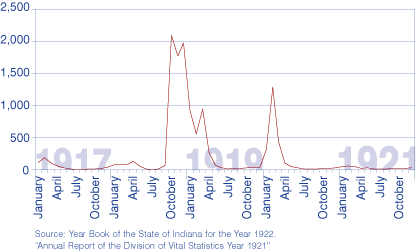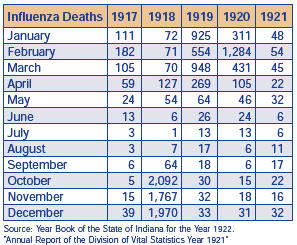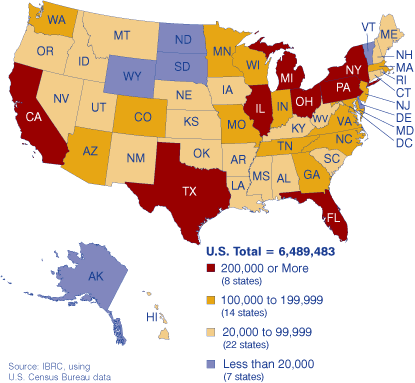Inside the Data Center
Potential Economic Effect of a Flu Pandemic
Much is heard in the news these days about avian flu and the potential of a flu pandemic. By the middle of January 2006, the issue had pushed its way to the home pages of many prominent websites, including those of the White House, the U.S. Department of Health and Human Services, the Centers for Disease Control and Prevention (CDC), the World Health Organization (WHO) and the Indiana State Department of Health. The federal government has even created a website dedicated to the issue (www.PandemicFlu.gov).
The October 7, 2005, issue of Science reported that researchers from the CDC and their colleagues were able to reconstruct the flu virus that caused the flu pandemic that killed upwards of 50 million people worldwide (an estimated 675,000 in the United States) in 1918–19. There were two other flu pandemics in the 20th century (1957 and 1968) but neither was as deadly as the 1918 pandemic (see Figure 1 and Table 1).
Figure 1: Hoosier Deaths due to Influenza, 1917 to 1921

Table 1: Hoosier Influenza Deaths

The "Report of the State Board of Health For the Year Ending September 30, 1919," (1) shows that the flu epidemic was first recognized about September 20, 1918, spreading to every corner of the state by October 20. The epidemic reached a maximum about October 25 and then declined until about November 15 when a second recurrence began, ending by January 1, 1919. On October 9, schools, churches and theaters were ordered closed and public gatherings were forbidden. This order was lifted on November 2 when officials realized that the closings had very little effect in controlling the spread of the flu. By the end of the epidemic, a total of $8,269.09 was spent by the federal government in Indiana to help control the epidemic (or over $90,000 when adjusted for inflation).
A 1999 CDC report estimated that a flu pandemic in the United States could result in 89,000 to 207,000 deaths; 314,000 to 734,000 hospitalizations; and 18 to 42 million outpatient visits. The authors estimated that the impact to the economy would be anywhere from $71.3 to $166.5 billion, excluding disruptions to commerce and society.
More recently, a December 2005 Congressional Budget Office report discusses two economic impact scenarios of a potential avian flu pandemic. In the most severe scenario, one similar to the 1918–19 outbreak, about 90 million people would fall ill and 2 million would die in the United States. Real GDP would drop by about 5 percent over the next year, comparable to the effect of a typical business-cycle recession. In the second, milder scenario, one similar to the 1957 and 1968 pandemics, about 75 million would become sick in the United States and about 100,000 would die. GDP would drop by about 1.5 percent but would not cause a recession.
For more information on the avian flu, flu pandemics and preparedness or response plans, visit:
- The Center for Disease Control and Prevention: www.cdc.gov
- FluPandemic.gov: www.pandemicflu.gov/
- Indiana State Department of Health: www.in.gov/isdh
Women-Owned Firms in Indiana: 2002
The Census Bureau recently released the 2002 Survey of Business Owners: Women-Owned Firms report. Nationally, women-owned businesses grew at twice the national average between 1997 and 2002. The 6.5 million firms brought in about $950 in sales and receipts.
In Indiana, 118,857 women-owned firms, roughly 27.4 percent of all businesses in the state, generated almost $16.5 billion in revenue. The 16,218 firms with paid employees employed 136,457 people (see Figure 2).
Figure 2: Women-Owned Businesses by State, 2002

To read the complete report, visit the Census website at https://www.census.gov/library/publications/2006/econ/2002-sbo-women.html. To view national and state-level data from the 2002 Survey of Business Owners, go to https://www.census.gov/programs-surveys/sbo.html.
Notes
- Reports discussed in the article:
- “The Economic Impact of Pandemic Influenza in the United States: Priorities for Intervention” Emerging Infectious Diseases, 5:5 September–October 1999. https://wwwnc.cdc.gov/eid/article/5/5/99-0507_article
- “A Potential Influenza Pandemic: Possible Macroeconomic Effects and Policy Issues.” Congressional Budget Office December 2005. https://www.cbo.gov/sites/default/files/109th-congress-2005-2006/reports/12-08-birdflu.pdf
- “Report of the State Board of Health For the Year Ending September 30, 1919”. Year Book of the State of Indiana for the Year 1919 (Indianapolis, IN: Legislative Reference Bureau, 1920).
Frank Wilmot, State Data Coordinator
Indiana State Library
